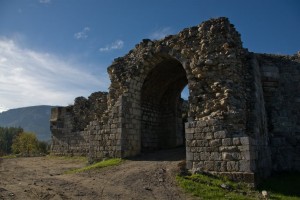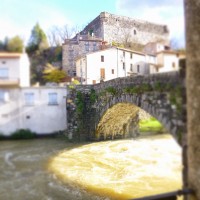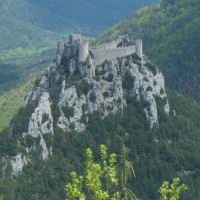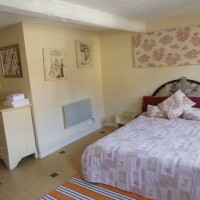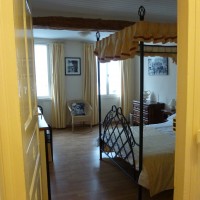Some might say that Quillan’s chateau looks more like a fort than a mediaeval castle. Whether or not that is true, the history of this lovely old monument is a long and colourful one…
There has been a building of sorts on this spot since Roman times — first a Roman village, then a Visigoth fortress, and later the chateau as you see it today. In its long and colourful history, the chateau has been sacked by Simon de Montfort’s army during the Albigensian crusade, it has belonged to various kings of both Aragon and France, it has had its walls dismantled during the French revolution to create a platform for canons, and much more (the timeline is below).
The chateau is a quadrangular enclosure of 35m square, with thick walls. This type of construction was used only for a short period during the Middle Ages, and the walls at Quillan can be dated as being 13th century. Towards the tops of the walls you can see a change of construction, possibly dating to one of the periods when the castle was renovated.
The classic mediaeval defence system included an exterior moat (long since gone), an exterior door and drawbridge, two interior doors with a deadfall in between, and archery slits. The main entrance is on the north/north-east side and is believed to have had a large square tower above it, 8m x 6m, consisting of three arches peaking at a height of 26m. It is the possible existence of this tower that makes Quillan’s castle such an important site. The normal defence system for such a mediaeval castle would be a tower door flanked by two towers — and indeed there are several examples of this in the area. But if, as many experts believe, the tower is above the entrance, then Quillan’s chateau is unique in the Aude region. The tower door is damaged, but this allows you to see that the wall is made from river stones.
Over the last few years a programme of renovation and consolidation has begun. During this time the interior space has been partially cleared of the trees and rocks that had encumbered it. It then became clear that there were internal structures with large arches of which only the buttresses in the walls and the floor remain.
The south wall is the best preserved of the four, and it is up to the south side of the castle that our river balcony looks. Almost its original height, the only thing missing are the battlements, but you can still just about make out the walkway along the top (you may need a little imagination here).
Occupying around 25 per cent of the surface of the interior space is a huge water tower built in the 20th century, before restoration and preservation became fashionable. These considerations aside, its height and proximity to the town make it an obvious place for the water tower.
There are stunning views of the town and surrounding mountains from the chateau so well worth the walk over the bridge and up the winding lane to its entrance.
Timeline of Quillan
- In Roman times, a village existed here called Calianum; the village houses were built on the right bank of the river Atax (now called the Aude)
- Around 781, a Visigoth fortress is mentioned in the village now called Kilianus or Quilhanus
- In 844, King Charles the Bald put pressure on the local Count to return the village and its lands to the Archbishop of Narbonne
- In the 11th century, the village spread to the left bank of the river
- By 1125, the village, now a town, was fortified
- In 1145, the town was renamed Quillanum
- In the late 12th century, Alfonso II of Aragon took the town after a short battle in the war against Viscount Trencavel of Carcassonne
- By 1202, the Archbishop of Narbonne recovered his rights over Quillan
- Around 1210, during the Albigensian Crusade, the castle was taken by Simon de Montfort’s army and he awarded it to Guy de Lévis, his faithful lieutenant, much to the outrage of the Archbishop of Narbonne
- In 1216, the Archbishop of Narbonne wrote a petition to Pope Honorius asking to have his rights restored at Quillan
- In 1232, the existing castle was built on the site of the old Visigoth fortress; power over Quillan at this time alternated between the King of France and the Archbishop of Narbonne
- In 1247, St. Louis (King of France) decided to create several cities in the south including Limoux; Quillan too was elevated to city status and named Quillanus
- In 1280, King Philip III finally abandoned all land and rights to the Archbishop of Narbonne
- In 1281, the garrison was established, overseen by an appointee of the Archbishop
- In 1332, the castle was given to the King of France, leading to a renovation of the castle
- In 1341, the renovation of the castle was complete
- In 1345, famine decimated the region
- In 1347, the first black plague hit Quillan
- In 1350, the second plague decimated the population, killing two thirds
- In 1351 a text mentions that the Quillan diocese “has its own beautiful castle with two adjacent orchards”
- In 1394, during the Hundred Years War, the castle was fortified
- By 1480, the Aragonese troops ravaged the regions of Fenouillèdes and the Upper Aude Valley; the Spanish occupied Quillan
- In 1495, troops of the King of France drove the intruders from the city and the castle
- In 1573, the Calvinists took the city
- In 1575, the castle of Quillan was burned by the Huguenots
- In 1576, the Vicomte de Joyeuse fortified the town further and ditches were dug; but by the end of the wars of religion, it seems that the castle was in significant disrepair
- In 1628, the Seneschal of Carcassonne requested the Archbishop to begin a restoration of the castle and the mill after an inspection
- In 1659, the Treaty of the Pyrénées sealed a peace between Spain and France, and this allowed for the annexation of the Roussillon meaning that Quillan found itself on the Spanish border and fortifications were no longer relevant
- In 1735, the castle was decommissioned on the orders of the Archbishop
- In 1790, during the revolution, Quillan became the chief town of the district
- In 1793, the west and north walls were dismantled so that the stone could be used to create a platform to serve a battery of cannon
- In 1791, the chateau was sold at auction and purchased by one Thomas Marre
- In 1950 it was bought back by the town and a water tower constructed inside — perhaps a sensible topographic and economic decision, but a catastrophe for the monument.
- In 1954, the castle ruins were granted the status of a historical monument
- In 1994, excavations were organized, and a long period of a restoration work began which is still ongoing
Material on this page was extracted and translated from www.patrimoine-quillan.com

